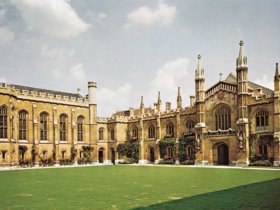Cambridge is the first college globally to announce the following 1. Five Degrees Science-Based Target for carbon discount, committing itself to have no strength-related carbon emissions via 2048. The University has also expressed an aspiration to be ten years ahead of its Science-Based Target decarbonization pathway at all times and to attain zero-carbon through 2038, with a steep 75% lower on 2015 emissions by 2030. “Scientists have made it clear that we want to take pressing motion to prevent doubtlessly catastrophic weather change,” says Professor Ian Leslie, Senior Adviser to the Vice-Chancellor with a unique responsibility for Environmental Sustainability. “As an international-leading University, we want to take responsibility for our carbon emissions now and demonstrate to others what is manageable. By setting a bold goal for carbon discount and aiming to reach it a decade early, we are hoping to provide opportunities for others to research from our technique, which includes in which we are a hit and regions that are observed to be hard.” Science-Based Targets are based on independently developed fashions of what organizations want to do. Cambridge’s goal is focused on Scope One and a couple of emissions objectives: scope one emission are direct emissions from owned or controlled assets; Scope Two emissions are indirect emissions from the technology of purchased electricity. “The important factor approximately Science Based Targets is that they may be now not arbitrary, however rather are strong and evidence-based totally,” adds Dr. Emily Shuckburgh, Director of Research on Carbon Neutrality at the University of Cambridge. Dr. Shuckburgh also leads the Cambridge Carbon Neutral Futures Initiative, which will launch in the autumn. “Achieving our dedication will surely be hard. However, it is a task we must satisfy. We encourage other universities and establishments to consider adopting similar commitments.” Initially, the new commitment applies to the University’s operational property, which includes buildings and belongings that guide its coaching and studies activities. The University is growing Science-Based Targets for its wider property and sports over the subsequent three years.
Work that is already underway to reach the dedication consists of the following:
• searching for alternatives to significantly lessen the amount of fuel that the University makes use of for space and water heating; • assessing the feasibility of developing a solar farm on University land; • sourcing all the University’s strength from zero-carbon sources; • a program of power performance upgrades across the University’s estate. The University is likewise taking steps to ensure that carbon is key attention in selections referring to the development of recent homes. Other proposals within the pipeline include providing the University’s departments with better data on their electricity use and carbon emissions so that personnel and students are informed to do so and measure the effect. The University has additionally devoted itself to expanding objectives for lowering its oblique (scope three) carbon emissions, such as those from its delivery chain and enterprise journey. It is growing several projects to lessen these. Science-Based Targets are advanced in the usage of fashions that calculate the level of carbon reduction a specific company desires to obtain to do its ‘honest proportion’ in reducing worldwide emissions. As their place to begin, the models mirror the quantity through which international emissions need to be reduced to ensure that the goals set out within the 2015 Paris Agreement are executed. The Paris Agreement, a global reaction to the threat of weather alternates, aims to limit the increase in common global temperature throughout this century to nicely underneath two tiers Celsius (measured towards pre-industrial degrees), ideally proscribing the temperature boom even further to 1.Five stages Celsius. The University’s Science-Based Target is primarily based on the 1. Five degrees restrict. It suggests how a great deal and how quickly the University needs to lessen its emissions to ensure it’s far doing sufficient to help lessen global emissions to the ranges that the modern-day climate technological know-how says is necessary to prevent the worst results of weather trade. The models and information underlying the improvement of Science Base Targets are supplied via the Science Based Targets Initiative and the International Energy Agency. Companies adopting their Science-Based Targets can also have them assessed and established using the Initiative, although this provider isn’t always yet available to the higher education quarter. The University’s goal has not been confirmed. Still, it’s been advanced with an outside consultant who has direct, relevant enjoy and is a member of the Initiative’s Technical Advisory Group.












